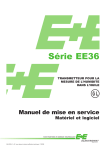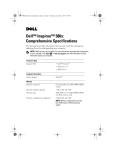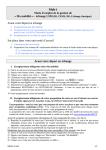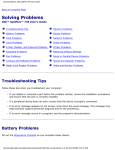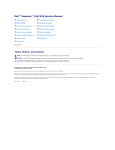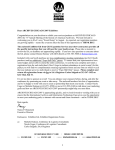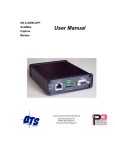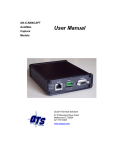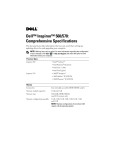Download Dell 2010 User's Manual
Transcript
book.book Page 1 Monday, November 19, 2012 11:42 AM Dell™ Dimension™ 2010 Service Manual Model D05M Type D05M001 w w w. d e l l . c o m | s u p p o r t . d e l l . c o m book.book Page 2 Monday, November 19, 2012 11:42 AM Notes, Cautions, and Warnings NOTE: A NOTE indicates important information that helps you make better use of your computer. CAUTION: A CAUTION indicates potential damage to hardware or loss of data if instructions are not followed. WARNING: A WARNING indicates a potential for property damage, personal injury, or death. ____________________ Information in this document is subject to change without notice. © 2009 Dell Inc. All rights reserved. Reproduction of these materials in any manner whatsoever without the written permission of Dell Inc. is strictly forbidden. Trademarks used in this text: Dell, the DELL logo, and Dimension are trademarks of Dell Inc.; Microsoft and Windows are either trademarks or registered trademarks of Microsoft Corporation in the United States and/or other countries. Other trademarks and trade names may be used in this document to refer to either the entities claiming the marks and names or their products. Dell Inc. disclaims any proprietary interest in trademarks and trade names other than its own. Model D05M July 2009 Type D05M001 Rev. A00 book.book Page 3 Monday, November 19, 2012 11:42 AM Contents 1 Technical Overview . . . . . . . . . . . . . . . . . . Inside View of Your Computer System Board Components 2 Before You Begin Recommended Tools 4 7 . . . . . . . . . . . . . . . . 8 11 . . . . . . . . . . . . . . . . 11 . . . . . . . . . . . . . . . . . . 11 . . . . . . . . . . . . . . . 11 Safety Instructions . . . . . . . . . . . . . . . . . . . 12 Computer Cover . . . . . . . . . . . . . . . . . . . 15 Turning Off Your Computer 3 . . . . . . . . . . . . . . . . . . . . . . . . . . . . . . . . Technical Specifications 7 Removing the Computer Cover . . . . . . . . . . . . . 15 Replacing the Computer Cover . . . . . . . . . . . . . 16 . . . . . . . . . . . . . . . . . . . . . . . 19 Front Bezel Removing the Front Bezel . . . . . . . . . . . . . . . . Replacing the Front Bezel . . . . . . . . . . . . . . . . Contents 19 20 3 book.book Page 4 Monday, November 19, 2012 11:42 AM 5 Memory Module(s) . . . . . . . . . . . . . . . . . Removing Memory Module(s) . . . . . . . . . . . . . . Replacing Memory Module(s) . 6 . . . . . . . . . . . . . PCI and PCI Express Cards . . . . . . . . . . . 8 22 25 . . . . . . . . . 25 Replacing PCI and PCI Express Cards . . . . . . . . . 27 Drives . . . . . 30 . . . . . . . . . . . . . . . . . . . . . . . . . . . 31 Removing a Hard Drive . . . . . . . . . . . . . . . . . 31 Replacing a Hard Drive . . . . . . . . . . . . . . . . . 33 Removing a Media Card Reader . . . . . . . . . . . . 33 Replacing a Media Card Reader . . . . . . . . . . . . 35 Removing an Optical Drive . . . . . . . . . . . . . . . 37 Replacing an Optical Drive . . . . . . . . . . . . . . . 39 Power Switch Module . . . . . . . . . . . . . . . 43 Removing the Power Switch Module . . . . . . . . . . Replacing the Power Switch Module . 4 21 Removing PCI and PCI Express Cards . Configuring Your Computer After Removing or Installing a PCI/PCI Express Card . . . . . . . 7 21 Contents . . . . . . . . . 43 45 book.book Page 5 Monday, November 19, 2012 11:42 AM 9 Front I/O Panel . . . . . . . . . . . . . . . . . . . . Removing the Front I/O Panel . . . . . . . . . . . . . . Replacing the Front I/O Panel . . . . . . . . . . . . . . 10 Processor Fan and Heat Sink Assembly 47 48 51 Removing the Processor Fan and Heat Sink Assembly . . . . . . . . . . . . . . . . . . . Replacing the Processor Fan and Heat Sink Assembly . . . . . . . . 11 Processor 47 51 . . . . . . . . . . . 53 . . . . . . . . . . . . . . . . . . . . . . . . 55 Removing the Processor . . . . . . . . . . . . . . . . 55 Replacing the Processor . . . . . . . . . . . . . . . . 57 . . . . . . . . . . . . . . . . . . . . . 59 12 System Board Removing the System Board . . . . . . . . . . . . . . 59 Replacing the System Board . . . . . . . . . . . . . . 61 . . . . . . . . . . . . . . . . . . . . . 63 13 Power Supply Removing the Power Supply . . . . . . . . . . . . . . 63 Replacing the Power Supply . . . . . . . . . . . . . . 64 Contents 5 book.book Page 6 Monday, November 19, 2012 11:42 AM 14 Battery . . . . . . . . . . . . . . . . . . . . . . . . . . . Removing the Battery . . . . . . . . . . . . . . . . . . 67 Replacing the Battery . . . . . . . . . . . . . . . . . . 68 . . . . . . . . . . . . . . . . . . . . . 69 . . . . . . . . . . . . . . . . . . . . . . . . 69 15 System Setup . Overview . Entering System Setup . . . . . . . . . . . . . . . . . . . . . . . . . . . . . . . . . 69 System Setup Options . . . . . . . . . . . . . . . 71 . . . . . . . . . Changing Boot Sequence for Future Boots . . . . Flashing the BIOS 74 74 . . 75 . . . . . . . . . . . . . . . . . . . . 76 Clearing Forgotten Passwords and CMOS Settings Contents 69 System Setup Screens Changing Boot Sequence for the Current Boot . . . . . . . . . . . 6 67 book.book Page 7 Monday, November 19, 2012 11:42 AM 1 Technical Overview WARNING: Before working inside your computer, read the safety information that shipped with your computer. For additional safety best practices information, see the Regulatory Compliance Homepage at www.dell.com/regulatory_compliance. Inside View of Your Computer 4 3 2 1 5 6 Technical Overview 7 book.book Page 8 Monday, November 19, 2012 11:42 AM 1 power supply 2 optical drive 3 Media Card Reader 4 front bezel 5 hard drive 6 system board System Board Components 1 2 3 4 5 6 17 16 15 7 14 8 9 13 8 Technical Overview 12 11 10 book.book Page 9 Monday, November 19, 2012 11:42 AM 1 12 V power connector (PWR2) 2 processor socket 3 processor fan connector (CPU_FAN) 4 memory module connector (DIMM1) 5 memory module connector (DIMM2) 6 main power connector (PWR1) 7 SATA connector (SATA_3) 8 SATA connector (SATA_1) 9 media card reader connector (F_USB2) 10 front panel USB connector (F_USB1) 11 USB power connector (USB_PWR1) 12 power switch module connector (FP1) 13 front panel audio (F_AUDIO) 14 PCI card slot (PCI2) 15 battery socket (BAT) 16 PCI-Express x16 card slot (PCI-E1_16X) 17 CMOS reset jumper (CLR_CMOS) Technical Overview 9 book.book Page 10 Monday, November 19, 2012 11:42 AM 10 Technical Overview book.book Page 11 Monday, November 19, 2012 11:42 AM 2 Before You Begin This manual provides procedures for removing and installing the components in your computer. Unless otherwise noted, each procedure assumes that the following conditions exist: • You have performed the steps in "Turning Off Your Computer" on page 11 and "Safety Instructions" on page 12. • You have read the safety information that ships with your computer. • A component can be replaced or—if purchased separately—installed by performing the removal procedure in reverse order. Technical Specifications For information on technical specifications of your computer, see the Setup Guide that shipped with your computer or see the Dell Support website at support.dell.com/manuals. Recommended Tools The procedures in this document may require the following tools: • Small Phillips screwdriver • Small flat-blade screwdriver Turning Off Your Computer CAUTION: To avoid losing data, save and close all open files and exit all open programs before you turn off your computer. 1 Shut down the operating system. Before You Begin 11 book.book Page 12 Monday, November 19, 2012 11:42 AM 2 Ensure that the computer and all attached devices are turned off. If your computer and attached devices did not automatically turn off when you shut down your operating system, press and hold the power button for about 4 seconds to turn them off. Safety Instructions Use the following safety guidelines to help protect your computer from potential damage and to help to ensure your own personal safety. WARNING: Before working inside your computer, read the safety information that shipped with your computer. For additional safety best practices information, see the Regulatory Compliance Homepage at www.dell.com/regulatory_compliance. CAUTION: Only a certified service technician should perform repairs on your computer. Damage due to servicing that is not authorized by Dell is not covered by your warranty. CAUTION: When you disconnect a cable, pull on its connector or on its pull-tab, not on the cable itself. Some cables have connectors with locking tabs; if you are disconnecting this type of cable, press in on the locking tabs before you disconnect the cable. As you pull connectors apart, keep them evenly aligned to avoid bending any connector pins. Also, before you connect a cable, ensure that both connectors are correctly oriented and aligned. CAUTION: To avoid damaging the computer, perform the following steps before you begin working inside the computer. 1 Ensure that the work surface is flat and clean to prevent the computer cover from being scratched. 2 Turn off your computer (see "Turning Off Your Computer" on page 11). CAUTION: To disconnect a network cable, first unplug the cable from your computer and then unplug the cable from the network device. 3 Disconnect all telephone or network cables from the computer. 4 Disconnect your computer and all attached devices from their electrical outlets. 5 Press and hold the power button while the system is unplugged to ground the system board. 12 Before You Begin book.book Page 13 Monday, November 19, 2012 11:42 AM CAUTION: Before touching anything inside your computer, ground yourself by touching an unpainted metal surface, such as the metal at the back of the computer. While you work, periodically touch an unpainted metal surface to dissipate static electricity, which could harm internal components. Before You Begin 13 book.book Page 14 Monday, November 19, 2012 11:42 AM 14 Before You Begin book.book Page 15 Monday, November 19, 2012 11:42 AM 3 Computer Cover WARNING: Before working inside your computer, read the safety information that shipped with your computer. For additional safety best practices information, see the Regulatory Compliance Homepage at www.dell.com/regulatory_compliance. WARNING: To guard against electrical shock, always unplug your computer from the electrical outlet before removing the cover. WARNING: Do not operate your equipment with any cover(s) (including computer covers, bezels, filler brackets, front-panel inserts, etc.) removed. CAUTION: Ensure that sufficient space exists to support the system with the cover removed—at least 30 cm (1 ft.) of desk top space. Removing the Computer Cover 1 Follow the procedures in "Before You Begin" on page 11. 2 Lay your computer on its side with the computer cover facing up. 3 Remove the two screws securing the cover, using a screwdriver. Computer Cover 15 book.book Page 16 Monday, November 19, 2012 11:42 AM 1 2 3 1 front of computer 2 computer cover 3 screws (2) 4 Release the computer cover by pulling it away from the front of the computer and lifting it up. 5 Set the cover aside in a secure location. NOTE: To remove the computer cover on the other side, lay the computer on its side with the unremoved cover facing up, and then perform step 3 to step 5. Replacing the Computer Cover 1 Ensure that all cables are connected, and fold cables out of the way. 2 Ensure that no tools or extra parts are left inside the computer. 3 Align the tabs at the bottom of the computer cover with the slots located along the edge of the computer. 4 Press the computer cover down and slide it towards the front of the computer until you feel a click or feel the computer cover securely installed. 16 Computer Cover book.book Page 17 Monday, November 19, 2012 11:42 AM 5 Ensure that the cover is seated correctly. 6 Replace the two screws that secure the computer cover, using a screwdriver. 1 2 4 3 1 front of the computer 2 computer cover 3 screws (2) 4 slot 7 Place the computer in an upright position. CAUTION: Ensure that none of the system air-vents are blocked. Blocking them would cause serious thermal problems. Computer Cover 17 book.book Page 18 Monday, November 19, 2012 11:42 AM 18 Computer Cover book.book Page 19 Monday, November 19, 2012 11:42 AM 4 Front Bezel WARNING: Before working inside your computer, read the safety information that shipped with your computer. For additional safety best practices information, see the Regulatory Compliance Homepage at www.dell.com/regulatory_compliance. WARNING: To guard against electrical shock, always unplug your computer from the electrical outlet before removing the cover. WARNING: Do not operate your equipment with any cover(s) (including computer covers, bezels, filler brackets, front-panel inserts, etc.) removed. Removing the Front Bezel 1 Follow the procedures in "Before You Begin" on page 11. 2 Remove the computer cover from both the sides (see "Removing the Computer Cover" on page 15). 3 Place the computer in an upright position. 4 Press out the six front bezel clamps to release it from the front panel. Front Bezel 19 book.book Page 20 Monday, November 19, 2012 11:42 AM 5 Pull the front bezel away from the front of the computer to release it from the front bezel inserts. 6 Set aside the front bezel in a secure location. Replacing the Front Bezel 1 Align the clamps of the front bezel to the front panel and press it towards the computer until the front bezel clamps snap into place. 2 Replace the computer cover on both the sides (see "Replacing the Computer Cover" on page 16). 20 Front Bezel book.book Page 21 Monday, November 19, 2012 11:42 AM 5 Memory Module(s) WARNING: Before working inside your computer, read the safety information that shipped with your computer. For additional safety best practices information, see the Regulatory Compliance Homepage at www.dell.com/regulatory_compliance. WARNING: To guard against electrical shock, always unplug your computer from the electrical outlet before removing the cover. WARNING: Do not operate your equipment with any cover(s) (including computer covers, bezels, filler brackets, front-panel inserts, etc.) removed. Removing Memory Module(s) 1 Follow the procedures in "Before You Begin" on page 11. 2 Remove the computer cover (see "Removing the Computer Cover" on page 15). 3 Locate the memory modules on the system board (see "System Board Components" on page 8). 4 Press out the securing clip at each end of the memory module connector. 2 1 1 memory module connector 2 securing clips (2) 5 Grasp the memory module and pull it upwards. If the memory module is difficult to remove, gently ease the memory module back and forth to remove it from the connector. Memory Module(s) 21 book.book Page 22 Monday, November 19, 2012 11:42 AM Replacing Memory Module(s) 1 Follow the procedures in "Before You Begin" on page 11. 2 Press out the securing clip at each end of the memory module connector. CAUTION: Do not install ECC memory modules. 3 Align the notch on the bottom of the memory module with the tab in the memory module connector. 4 2 3 1 1 cutouts (2) 2 tab 3 notch 4 memory module CAUTION: To avoid damage to the memory module, press the memory module straight down into the connector while you apply equal force to each end of the memory module. 4 Insert the memory module into the memory module connector until the memory module snaps into position. If you insert the memory module correctly, the securing clips snap into the cutouts at each end of the memory module. 22 Memory Module(s) book.book Page 23 Monday, November 19, 2012 11:42 AM 2 1 1 cutouts (2) 2 securing clip (snapped in position) 5 Replace the computer cover (see "Replacing the Computer Cover" on page 16). 6 Connect your computer and devices to electrical outlets, and then turn them on. If the message appears stating that memory size has changed, press <F1> to continue. 7 Log on to your computer. 8 Right-click the My Computer icon on your Microsoft® Windows® desktop and click Properties. 9 Click the General tab. 10 To verify that the memory is installed correctly, check the amount of memory (RAM) listed. Memory Module(s) 23 book.book Page 24 Monday, November 19, 2012 11:42 AM 24 Memory Module(s) book.book Page 25 Monday, November 19, 2012 11:42 AM PCI and PCI Express Cards 6 WARNING: Before working inside your computer, read the safety information that shipped with your computer. For additional safety best practices information, see the Regulatory Compliance Homepage at www.dell.com/regulatory_compliance. WARNING: To guard against electrical shock, always unplug your computer from the electrical outlet before removing the cover. WARNING: Do not operate your equipment with any cover(s) (including computer covers, bezels, filler brackets, front-panel inserts, etc.) removed. Removing PCI and PCI Express Cards 1 Follow the procedures in "Before You Begin" on page 11. 2 Remove the computer cover (see "Removing the Computer Cover" on page 15). 3 If necessary, disconnect any cables connected to the card. 4 Remove the screw the secures the card to the chassis. PCI and PCI Express Cards 25 book.book Page 26 Monday, November 19, 2012 11:42 AM 2 1 1 screw 2 card 5 Remove the card. 26 • For a PCI card, grasp the card by its top corners, and ease it out of its connector. • For a PCI Express x16 card, push the retention mechanism on the card connector as you grasp the card by its top corners, and then ease the card out of the connector. PCI and PCI Express Cards book.book Page 27 Monday, November 19, 2012 11:42 AM 1 2 3 4 1 PCI Express x16 card 2 PCI Express x16 card connector 3 securing tab 4 retention mechanism 6 If you are removing the card permanently, install a filler bracket in the empty card-slot opening. NOTE: Installing filler brackets over empty card-slot openings is necessary to maintain FCC certification of the computer. The brackets also keep dust and dirt out of your computer. 7 Replace the computer cover (see "Replacing the Computer Cover" on page 16). 8 Connect the computer and devices to electrical outlets, and then turn them on. 9 Remove the card’s driver from the operating system. 10 To complete the removal procedure, see "Configuring Your Computer After Removing or Installing a PCI/PCI Express Card" on page 30. Replacing PCI and PCI Express Cards 1 Follow the procedures in "Before You Begin" on page 11. 2 Remove the computer cover (see "Removing the Computer Cover" on page 15). 3 Prepare the card for installation. PCI and PCI Express Cards 27 book.book Page 28 Monday, November 19, 2012 11:42 AM See the documentation that came with the card for information on configuring the card, making internal connections, or otherwise customizing it for your computer. 4 If this is a new card installation, remove the break-away metal plate. 5 Place the card in the connector and press down firmly. Ensure that the card is fully seated in the slot. 5 1 2 4 3 1 not fully-seated card 2 fully-seated card 4 bracket within slot 5 break-away metal plate 3 bracket caught outside of slot If you are installing the PCI Express card into the x16 card connector, pull the retention mechanism and align the securing tab with the card connector. 28 PCI and PCI Express Cards book.book Page 29 Monday, November 19, 2012 11:42 AM 1 2 3 4 1 PCI Express x16 card 2 PCI Express x16 card connector 3 securing tab 4 retention mechanism 6 Place the card in the connector and press down firmly. Ensure that the card is fully seated in the slot. 7 Replace the screw that secures the card to the chassis 8 Connect any cables that should be attached to the card. See the documentation for the card for information about the card’s cable connections. CAUTION: Do not route card cables over or behind the cards. Cables routed over the cards can prevent the computer cover from closing properly or cause damage to the equipment. 9 Replace the computer cover (see "Replacing the Computer Cover" on page 16). 10 To complete the installation, see "Configuring Your Computer After Removing or Installing a PCI/PCI Express Card" on page 30. PCI and PCI Express Cards 29 book.book Page 30 Monday, November 19, 2012 11:42 AM Configuring Your Computer After Removing or Installing a PCI/PCI Express Card NOTE: For information on location of external connectors, see the Setup Guide. For information on installing drivers and software for your card, see the documentation that shipped with the card. Installed 30 Removed Sound Card 1 Enter system setup (see 1 Enter system setup (see Network Card 1 Enter system setup (see 1 Enter system setup (see "Entering System Setup" on page 69). 2 Go to Onboard Audio Controller and then change the setting to Disabled. 3 Connect the external audio devices to the sound card’s connectors. "Entering System Setup" on page 69). 2 Go to Onboard LAN Controller and then change the setting to Disabled. 3 Connect the network cable to the network card’s connector. PCI and PCI Express Cards "Entering System Setup" on page 69). 2 Go to Onboard Audio Controller and then change the setting to Enabled. 3 Connect the external audio devices to the computer’s back panel connectors. "Entering System Setup" on page 69). 2 Go to Onboard LAN Controller and then change the setting to Enabled. 3 Connect the network cable to the integrated network connector. book.book Page 31 Monday, November 19, 2012 11:42 AM 7 Drives WARNING: Before working inside your computer, read the safety information that shipped with your computer. For additional safety best practices information, see the Regulatory Compliance Homepage at www.dell.com/regulatory_compliance. WARNING: To guard against electrical shock, always unplug your computer from the electrical outlet before removing the cover. WARNING: Do not operate your equipment with any cover(s) (including computer covers, bezels, filler brackets, front-panel inserts, etc.) removed. Removing a Hard Drive CAUTION: If you are replacing a hard drive that contains data that you want to keep, back up your files before you begin this procedure. 1 Follow the procedures in "Before You Begin" on page 11. 2 Remove the computer cover from both the sides (see "Removing the Computer Cover" on page 15). 3 Disconnect the power cable and the data cable from the hard drive. NOTE: If you are not replacing the hard drive at this time, disconnect the other end of the data cable from the system board and set it aside. You can use the data cable to install a hard drive at a later time. For the location of the SATA connectors, see "System Board Components" on page 8. Drives 31 book.book Page 32 Monday, November 19, 2012 11:42 AM 1 2 1 power cable 2 data cable 3 3 screws (4) CAUTION: Ensure that you do not scratch the screw holes with the screwdriver as the hard disk circuit board assembly is exposed here. 4 Place the computer in an upright position. 5 Remove the four screws that secure the hard drive to the hard drive bay. 6 Slide the hard drive out towards the back of the computer. 7 If removing the hard drive changes the drive configuration, ensure that you reflect these changes in system setup (see "System Setup" on page 69). 32 Drives book.book Page 33 Monday, November 19, 2012 11:42 AM 8 Replace the computer cover on both the sides (see "Replacing the Computer Cover" on page 16). 9 Connect the computer and other devices to an electrical outlet. Replacing a Hard Drive 1 Follow the procedures in "Before You Begin" on page 11. 2 Remove the computer cover from both the sides (see "Removing the Computer Cover" on page 15). 3 Check the documentation for the hard drive to verify that it is configured for your computer. 4 Move the cables out of the way and slide the hard drive into the hard drive bay. 5 Align and replace the four screws that secure the hard drive to the hard drive bay. 6 Connect the power and data cables to the hard drive. 7 Ensure that you connect the data cable to the system board connector, if you disconnected it while removing the hard drive. For the location of the SATA connectors, see "System Board Components" on page 8. 8 Check all cables to be certain that they are properly connected and firmly seated. 9 Replace the computer cover on both the sides (see "Replacing the Computer Cover" on page 16). 10 Connect your computer and devices to electrical outlets, and then turn them on. 11 See the documentation that came with the hard drive for instructions on installing any software required for drive operation. 12 Check the System Setup for drive configuration changes (see "Entering System Setup" on page 69). Removing a Media Card Reader 1 Follow the procedures in "Before You Begin" on page 11. Drives 33 book.book Page 34 Monday, November 19, 2012 11:42 AM 2 Remove the computer cover from both the sides (see "Removing the Computer Cover" on page 15). 3 Remove the front bezel (see "Removing the Front Bezel" on page 19). 2 1 1 FlexBay USB cable 2 screws (2) 4 Disconnect the FlexBay USB cable from the Media Card Reader connector on the system board. For the location of the connector, see "System Board Components" on page 8. 5 Remove the two screws that secure the Media Card Reader to the FlexBay slot. 34 Drives book.book Page 35 Monday, November 19, 2012 11:42 AM 6 Slide the Media Card Reader out through the front of the computer. 7 Replace the front bezel (see "Replacing the Front Bezel" on page 20). 8 Replace the computer cover on both the sides (see "Replacing the Computer Cover" on page 16). 9 Connect your computer and devices to electrical outlets, and then turn them on. Replacing a Media Card Reader 1 Follow the procedures in "Before You Begin" on page 11. 2 Remove the computer cover from both the sides (see "Removing the Computer Cover" on page 15). 3 Remove the front bezel (see "Removing the Front Bezel" on page 19). 4 If this is a new Media Card Reader installation, remove the break-away metal plate. Drives 35 book.book Page 36 Monday, November 19, 2012 11:42 AM 1 1 break-away metal plate 5 Gently slide the Media Card Reader into place in the FlexBay slot. 36 Drives book.book Page 37 Monday, November 19, 2012 11:42 AM 6 Align the screw holes in the Media Card Reader with the screw holes in the FlexBay slot. 7 Replace the two screws that secure the Media Card Reader to the FlexBay slot. NOTE: Ensure that the Media Card Reader is installed before the FlexBay USB cable is connected. 8 Connect the FlexBay USB cable to the Media Card Reader connector on the system board. For the location of the connector, see "System Board Components" on page 8. 9 Replace the front bezel (see "Replacing the Front Bezel" on page 20). 10 Replace the computer cover on both the sides (see "Replacing the Computer Cover" on page 16). 11 Connect your computer and devices to electrical outlets, and then turn them on. Removing an Optical Drive 1 Follow the procedures in "Before You Begin" on page 11. 2 Remove the computer cover from both the sides (see "Removing the Computer Cover" on page 15). 3 Remove the front bezel (see "Removing the Front Bezel" on page 19). 4 Disconnect the power cable and the data cable from the back of the optical drive. NOTE: If you are not replacing the optical drive at this time, disconnect the other end of the data cable from the system board and set it aside. You can use the data cable to install an optical drive at a later time. For the location of the SATA connectors, see "System Board Components" on page 8. Drives 37 book.book Page 38 Monday, November 19, 2012 11:42 AM 1 2 3 1 power cable 2 data cable 3 screws (4) 5 Remove the four screws that secure the optical drive to the optical drive bay. 6 Slide the optical drive out through the front of the computer. 7 Replace the front bezel (see "Replacing the Front Bezel" on page 20). 8 Replace the computer cover on both the sides (see "Replacing the Computer Cover" on page 16). 9 Connect your computer and devices to electrical outlets, and then turn them on. 38 Drives book.book Page 39 Monday, November 19, 2012 11:42 AM 10 Configure the drives in system setup (see "System Setup Options" on page 71). Replacing an Optical Drive 1 Follow the procedures in "Before You Begin" on page 11. 2 Remove the computer cover from both the sides (see "Removing the Computer Cover" on page 15). 3 Remove the front bezel (see "Removing the Front Bezel" on page 19). 4 If you are installing an optical drive in the secondary optical drive slot, remove the break-away metal plate. 1 1 break-away metal plate Drives 39 book.book Page 40 Monday, November 19, 2012 11:42 AM 5 Gently slide the optical drive into place. 6 Align the screw holes in the optical drive with the screw holes in the optical drive bay. 7 Replace the four screws that secure the optical drive to the optical drive bay. 8 Connect the power and data cables to the optical drive. 9 Ensure that you connect the data cable to the system board connector, if you disconnected it while removing the optical drive. For the location of the SATA connectors, see "System Board Components" on page 8. 10 Replace the front bezel (see "Replacing the Front Bezel" on page 20). 11 Replace the computer cover on both the sides (see "Replacing the Computer Cover" on page 16). 12 Connect your computer and devices to their electrical outlets, and turn them on. See the documentation that came with the optical drive for instructions on installing any software required for drive operation. 13 Check the System Setup for drive configuration changes (see "Entering System Setup" on page 69). 40 Drives book.book Page 41 Monday, November 19, 2012 11:42 AM Drives 41 book.book Page 42 Monday, November 19, 2012 11:42 AM 42 Drives book.book Page 43 Monday, November 19, 2012 11:42 AM Power Switch Module 8 WARNING: Before working inside your computer, read the safety information that shipped with your computer. For additional safety best practices information, see the Regulatory Compliance Homepage at www.dell.com/regulatory_compliance. WARNING: To guard against electrical shock, always unplug your computer from the electrical outlet before removing the cover. WARNING: Do not operate your equipment with any cover(s) (including computer covers, bezels, filler brackets, front-panel inserts, etc.) removed. CAUTION: Ensure that sufficient space exists to support the system with the cover removed—at least 30 cm (1 ft.) of desk top space. Removing the Power Switch Module 1 Follow the procedures in "Before You Begin" on page 11. 2 Remove the computer cover from both the sides (see "Removing the Computer Cover" on page 15). 3 Remove the front bezel (see "Removing the Front Bezel" on page 19). 4 Remove the hard drive (see "Removing a Hard Drive" on page 31). 5 Disconnect the power switch module cable from power switch module connector (FP1) on the system board. For the location of the connector, see "System Board Components" on page 8. 6 Gently release the hard drive activity light from its holder. 7 Press the holder and rotate it outwards to remove it from the front panel. Power Switch Module 43 book.book Page 44 Monday, November 19, 2012 11:42 AM 1 2 1 44 hard drive activity light Power Switch Module 2 holder book.book Page 45 Monday, November 19, 2012 11:42 AM 8 Slide the holder along with the hard drive activity light and cable out through the front of the computer. Replacing the Power Switch Module 1 Slide the power switch module through the slot on the front panel. 2 Press the holder and gently snap it into the front panel until it clicks into place. 3 Gently push the hard drive activity light into its holder. 4 Connect the power switch module cable to the power switch module connector (FP1) on the system board. 5 Replace the hard drive (see "Replacing a Hard Drive" on page 33). 6 Replace the front bezel (see "Replacing the Front Bezel" on page 20). 7 Replace the computer cover on both the sides (see "Replacing the Computer Cover" on page 16). Power Switch Module 45 book.book Page 46 Monday, November 19, 2012 11:42 AM 46 Power Switch Module book.book Page 47 Monday, November 19, 2012 11:42 AM 9 Front I/O Panel WARNING: Before working inside your computer, read the safety information that shipped with your computer. For additional safety best practices information, see the Regulatory Compliance Homepage at www.dell.com/regulatory_compliance. WARNING: To guard against electrical shock, always unplug your computer from the electrical outlet before removing the cover. WARNING: Do not operate your equipment with any cover(s) (including computer covers, bezels, filler brackets, front-panel inserts, etc.) removed. Removing the Front I/O Panel NOTE: Note the routing of all cables as you remove them so that you can re-route them correctly when installing the new front I/O panel. 1 Follow the procedures in "Before You Begin" on page 11. 2 Remove the computer cover from both the sides (see "Removing the Computer Cover" on page 15). 3 Remove the front bezel (see "Removing the Front Bezel" on page 19). CAUTION: When removing the front I/O panel from the computer, be extremely careful. Carelessness may result in damage to the cable connectors and the cable routing clips. 4 Disconnect all the cables that are connected to the front I/O panel from the system board connectors. 5 Remove the screw that secures the front I/O panel to the chassis. 6 Carefully remove the front I/O panel from the computer. Front I/O Panel 47 book.book Page 48 Monday, November 19, 2012 11:42 AM 1 2 1 front I/O panel 2 screw Replacing the Front I/O Panel 1 Align the front I/O panel with the screw hole in the chassis. 48 Front I/O Panel book.book Page 49 Monday, November 19, 2012 11:42 AM 2 Replace the screw that secures the front I/O panel to the chassis. 3 Connect the cables to the system board connectors. 4 Replace the front bezel (see "Replacing the Front Bezel" on page 20). 5 Replace the computer cover on both the sides (see "Replacing the Computer Cover" on page 16). 6 Connect your computer and devices to an electrical outlet, and turn them on. Front I/O Panel 49 book.book Page 50 Monday, November 19, 2012 11:42 AM 50 Front I/O Panel book.book Page 51 Monday, November 19, 2012 11:42 AM Processor Fan and Heat Sink Assembly 10 WARNING: Before working inside your computer, read the safety information that shipped with your computer. For additional safety best practices information, see the Regulatory Compliance Homepage at www.dell.com/regulatory_compliance. WARNING: To guard against likelihood of electric shock, laceration by moving fan blades or other unexpected injuries, always unplug your computer from the electrical outlet before removing the cover. WARNING: Do not operate your equipment with any cover(s) (including computer covers, bezels, filler brackets, front-panel inserts, etc.) removed. Removing the Processor Fan and Heat Sink Assembly CAUTION: The processor fan with the heat sink is one single unit. Do not try to remove the fan separately. CAUTION: Do not touch the fan blades when you are removing the processor fan and heat sink assembly. This could damage the fan. 1 Follow the procedures in "Before You Begin" on page 11. 2 Remove the computer cover (see "Removing the Computer Cover" on page 15). 3 Disconnect the processor fan and heat sink assembly cable from the processor fan connector on the system board (see "System Board Components" on page 8). 4 Carefully move away any cables that are routed over the processor fan and heat sink assembly. CAUTION: Despite having a plastic shield, the heat sink fan assembly may be very hot during normal operation. Be sure that it has had sufficient time to cool before you touch it. Processor Fan and Heat Sink Assembly 51 book.book Page 52 Monday, November 19, 2012 11:42 AM 5 Rotate the clamp lever 180 degrees clockwise to release the clamp grip from the bracket projection. 6 Rotate the processor fan and heat sink assembly upward gently, and remove it from the computer. Lay the processor fan and heat sink assembly down on its top, with the thermal grease facing upward. 5 1 3 2 1 bracket 2 clamp lever 3 clamp grip 4 bracket projection 5 processor fan and heat sink assembly 4 NOTE: The processor fan and heat sink assembly in your computer may not look exactly like the one shown in the illustration above. 52 Processor Fan and Heat Sink Assembly book.book Page 53 Monday, November 19, 2012 11:42 AM Replacing the Processor Fan and Heat Sink Assembly CAUTION: When reinstalling the fan, ensure that you do not pinch the wires that run between the system board and the fan. 1 Clean the thermal grease from the bottom of the processor fan and heat sink assembly. CAUTION: Ensure that you apply new thermal grease. New thermal grease is critical for ensuring adequate thermal bonding, which is a requirement for optimal processor operation. 2 Apply the new thermal grease to the top of the processor. 3 Place the processor fan and heat sink assembly back onto the bracket. 4 Ensure that the two clamp grips are aligned with the two bracket projections. 5 Hold the processor fan and heat sink assembly in place and rotate the clamp lever 180 degrees counter-clockwise to secure the processor fan and heat sink assembly. Processor Fan and Heat Sink Assembly 53 book.book Page 54 Monday, November 19, 2012 11:42 AM 5 1 2 3 4 1 bracket 2 clamp lever 4 bracket projection 5 processor fan and heat sink assembly 3 clamp grip 6 Connect the processor fan and heat sink assembly cable to the processor fan connector on the system board (see "System Board Components" on page 8). 7 Replace the computer cover (see "Replacing the Computer Cover" on page 16). 8 Connect your computer and devices to an electrical outlet, and turn them on. 54 Processor Fan and Heat Sink Assembly book.book Page 55 Monday, November 19, 2012 11:42 AM 11 Processor WARNING: Before working inside your computer, read the safety information that shipped with your computer. For additional safety best practices information, see the Regulatory Compliance Homepage at www.dell.com/regulatory_compliance. WARNING: To guard against electrical shock, always unplug your computer from the electrical outlet before removing the cover. WARNING: Do not operate your equipment with any cover(s) (including computer covers, bezels, filler brackets, front-panel inserts, etc.) removed. Removing the Processor 1 Follow the procedures in "Before You Begin" on page 11. 2 Remove the computer cover (see "Removing the Computer Cover" on page 15). CAUTION: Despite having a plastic shield, the processor fan and heat sink assembly may be very hot during normal operation. Be sure that it has had sufficient time to cool before you touch it. 3 Remove the processor fan and heat sink assembly from the computer (see "Removing the Processor Fan and Heat Sink Assembly" on page 51). NOTE: Unless a new heat sink is required for the new processor, reuse the original processor fan and heat sink assembly when you replace the processor. Processor 55 book.book Page 56 Monday, November 19, 2012 11:42 AM 4 Press and push the release lever down and out to release it from the tab that secures it. 1 2 3 1 processor 3 socket 2 release lever CAUTION: When removing the processor, do not touch any of the pins inside the socket or allow any objects to fall on the pins in the socket. 5 Gently lift the processor to remove it from the socket. Leave the release lever extended in the release position so that the socket is ready for the new processor. 56 Processor book.book Page 57 Monday, November 19, 2012 11:42 AM Replacing the Processor CAUTION: Ground yourself by touching an unpainted metal surface on the back of the computer. CAUTION: When replacing the processor, do not touch any of the pins inside the socket or allow any objects to fall on the pins in the socket. 1 Follow the procedures in "Before You Begin" on page 11. 2 Unpack the new processor, being careful not to touch the underside of the processor. CAUTION: You must position the processor correctly in the socket to avoid permanent damage to the processor and the computer when you turn on the computer. 3 If the release lever on the socket is not fully extended, move it to that position. 4 2 3 1 1 socket 2 processor pin-1 indicator 3 processor 4 release lever 4 Align the pin-1 corners of the processor and socket. CAUTION: To avoid damage, ensure that the processor aligns properly with the socket, and do not use excessive force when you install the processor. Processor 57 book.book Page 58 Monday, November 19, 2012 11:42 AM 5 Set the processor lightly in the socket and ensure that the processor is positioned correctly. 6 Pivot the socket release lever back toward the socket, and snap it into place to secure the processor. 7 Clean the thermal grease from the bottom of the heat sink. CAUTION: Ensure that you apply new thermal grease. New thermal grease is critical for ensuring adequate thermal bonding, which is a requirement for optimal processor operation. 8 Apply the new thermal grease to the top of the processor. 9 Replace the processor fan and heat sink assembly (see "Replacing the Processor Fan and Heat Sink Assembly" on page 53). CAUTION: Ensure that the processor fan and heat sink assembly is correctly seated and secure. 10 Replace the computer cover (see "Replacing the Computer Cover" on page 16). 58 Processor book.book Page 59 Monday, November 19, 2012 11:42 AM 12 System Board WARNING: Before working inside your computer, read the safety information that shipped with your computer. For additional safety best practices information, see the Regulatory Compliance Homepage at www.dell.com/regulatory_compliance. WARNING: To guard against electrical shock, always unplug your computer from the electrical outlet before removing the cover. WARNING: Do not operate your equipment with any cover(s) (including computer covers, bezels, filler brackets, front-panel inserts, etc.) removed. CAUTION: Do not perform the following steps unless you are familiar with hardware removal and replacement. Performing these steps incorrectly could damage your system board. For information on contacting Dell, see the Setup Guide. Removing the System Board 1 Follow the procedures in "Before You Begin" on page 11. 2 Remove the computer cover (see "Removing the Computer Cover" on page 15). 3 Remove any add-in cards on the system board (see "Removing PCI and PCI Express Cards" on page 25). 4 Remove the processor fan and heat sink assembly (see "Removing the Processor Fan and Heat Sink Assembly" on page 51). 5 Remove the processor (see "Removing the Processor" on page 55). 6 Remove the memory modules (see "Removing Memory Module(s)" on page 21) and document which memory module is removed from each memory module connector so that the memory modules can be installed in the same location after the board is replaced. 7 Disconnect all cables from the system board. Note the routing of all cables as you remove them so that you can re-route them correctly after installing the new system board. 8 Remove the six screws from the system board. System Board 59 book.book Page 60 Monday, November 19, 2012 11:42 AM 9 Lift the system board up and out. 1 2 1 60 System Board screws (6) 2 system board book.book Page 61 Monday, November 19, 2012 11:42 AM Replacing the System Board 1 Gently align the system board into the chassis and slide it towards the back of the computer. 2 Replace the six screws that secure the system board to the chassis. 3 Route and connect the cables that you removed from the system board. CAUTION: Ensure that the processor fan and heat sink assembly is correctly seated and secure. 4 Replace the processor (see "Replacing the Processor" on page 57). 5 Replace the processor fan and the heat sink assembly (see "Replacing the Processor Fan and Heat Sink Assembly" on page 53). 6 Replace the memory modules into the same memory module connector from which you removed them (see "Replacing Memory Module(s)" on page 22). 7 Replace any add-in cards on the system board (see "Replacing PCI and PCI Express Cards" on page 27). 8 Replace the computer cover (see "Replacing the Computer Cover" on page 16). 9 Connect your computer and devices to an electrical outlet, and turn them on. System Board 61 book.book Page 62 Monday, November 19, 2012 11:42 AM 62 System Board book.book Page 63 Monday, November 19, 2012 11:42 AM 13 Power Supply WARNING: Before working inside your computer, read the safety information that shipped with your computer. For additional safety best practices information, see the Regulatory Compliance Homepage at www.dell.com/regulatory_compliance. WARNING: To guard against electrical shock, always unplug your computer from the electrical outlet before removing the cover. WARNING: Do not operate your equipment with any cover(s) (including computer covers, bezels, filler brackets, front-panel inserts, etc.) removed. Removing the Power Supply 1 Follow the procedures in "Before You Begin" on page 11. 2 Remove the computer cover (see "Removing the Computer Cover" on page 15). 3 Disconnect the DC power cables from the system board and the drives. Note the routing of the DC power cables underneath the tabs in the computer chassis as you remove them from the system board and drives. You must route these cables properly when you replace them to prevent them from being pinched or crimped. 4 Remove all the cables from the securing clip on the side of the power supply. 5 Remove the four screws that attach the power supply to the back of the computer chassis. Power Supply 63 book.book Page 64 Monday, November 19, 2012 11:42 AM 3 2 1 1 screws (4) 2 voltage selector switch 3 power supply 6 Slide out the power supply and lift it out. Replacing the Power Supply 1 Slide the replacement power supply towards the back of the computer. WARNING: Failure to replace and tighten all screws may cause electrical shock as these screws are a key part of the system grounding. 2 Replace the four screws that secure the power supply to the back of the computer chassis. NOTE: Route the DC power cables under the chassis tabs. The cables must be properly routed to prevent the cables from being damaged. 64 Power Supply book.book Page 65 Monday, November 19, 2012 11:42 AM 3 Connect the DC power cables to the system board and drives. 4 Secure all the cables to the securing clip on the side of the power supply. NOTE: Double-check all cable connections to make sure they are secure. 5 Replace the computer cover (see "Replacing the Computer Cover" on page 16). 6 Check the voltage selector switch (if applicable) to ensure that the correct voltage is selected. 7 Connect your computer and devices to an electrical outlet, and turn them on. Power Supply 65 book.book Page 66 Monday, November 19, 2012 11:42 AM 66 Power Supply book.book Page 67 Monday, November 19, 2012 11:42 AM Battery 14 WARNING: Before working inside your computer, read the safety information that shipped with your computer. For additional safety best practices information, see the Regulatory Compliance Homepage at www.dell.com/regulatory_compliance. WARNING: A new battery can explode if it is incorrectly installed. Replace the battery only with the same or equivalent type recommended by the manufacturer. Discard used batteries according to the manufacturer’s instructions. WARNING: To guard against electrical shock, always unplug your computer from the electrical outlet before removing the cover. WARNING: Do not operate your equipment with any cover(s) (including computer covers, bezels, filler brackets, front-panel inserts, etc.) removed. Removing the Battery 1 Record all the screens in system setup (see "System Setup" on page 69) so that you can restore the correct settings after the new battery has been installed. 2 Follow the procedures in "Before You Begin" on page 11. 3 Remove the computer cover (see "Removing the Computer Cover" on page 15). 4 Locate the battery socket (see "System Board Components" on page 8). CAUTION: If you pry the battery out of its socket with a blunt object, be careful not to touch the system board with the object. Ensure that the object is inserted between the battery and the socket before you attempt to pry out the battery. Otherwise, you may damage the system board by prying off the socket or by breaking circuit traces on the system board. Battery 67 book.book Page 68 Monday, November 19, 2012 11:42 AM 1 1 battery release lever 5 Press the battery release lever to remove the battery. Replacing the Battery 1 Insert the new battery (CR2032) into the socket with the side labeled "+" facing up, and press the battery into place. 2 Replace the computer cover (see "Replacing the Computer Cover" on page 16). 3 Connect your computer and devices to electrical outlets, and then turn them on. 4 Enter system setup (see "Entering System Setup" on page 69) and restore the settings you recorded in step 1. 68 Battery book.book Page 69 Monday, November 19, 2012 11:42 AM 15 System Setup Overview Use System Setup: • To change the system configuration information after you add, change, or remove any hardware in your computer. • To set or change a user-selectable option such as the user password. • To read the current amount of memory or set the type of hard drive installed. Before you use System Setup, it is recommended that you write down the system setup screen information for future reference. CAUTION: Do not change the settings in system setup unless you are an expert computer user. Certain changes can cause your computer to work incorrectly. Entering System Setup 1 Turn on (or restart) your computer. 2 When the DELL logo appears, press <F2> immediately. NOTE: Keyboard failure may result when a key on the keyboard is held down for extended periods of time. To avoid possible keyboard failure, press and release <F2> in even intervals until the system setup screen appears. NOTE: If you wait too long and the operating system logo appears, continue to wait until you see the Microsoft® Windows® desktop, then shut down your computer and try again. System Setup Screens Options List — This field appears on the top of the system setup window. The tabbed options contain features that define the configuration of your computer, including installed hardware, power conservation, and security features. System Setup 69 book.book Page 70 Monday, November 19, 2012 11:42 AM Option Field — This field contains information about each option. In this field you can view your current settings and make changes to your settings. Use the right- and left-arrow keys to highlight an option. Press <Enter> to make that selection active. Help Field — This field provides context sensitive help based on the options selected. Key Functions — This field appears below the Option Field and lists keys and their functions within the active system setup field. 70 System Setup book.book Page 71 Monday, November 19, 2012 11:42 AM System Setup Options NOTE: Depending on your computer and installed devices, the items listed in this section may not appear, or may not appear exactly as listed. System Info BIOS Info Displays the BIOS version and date information. System Displays the computer model number. Service Tag Displays the service tag of the computer. Asset Tag Displays the asset tag for the computer, if present. Processor Type Displays the processor type. CPU Speed Displays the processor speed. Processor L1 Cache Displays the amount of processor Level 1 cache. Processor L2 Cache Displays the amount of processor Level 2 cache. Processor L3 Cache Displays the amount of processor Level 3 cache. NOTE: The Processor L3 Cache field is displayed only if the processor supports L3 cache. Memory Installed Indicates the amount of installed memory. Memory Available Indicates the amount of available memory. Memory Speed Indicates the frequency of installed memory. Memory Channel Mode Indicates if the memory is in single or dual channel mode. Memory Technology Indicates the type of installed memory. Standard CMOS Features System Date Displays current date in the format (mm:dd:yy). System Time Displays current time in the format (hh:mm:ss). SATA-1 Displays the SATA drive connected to the SATA 1. SATA-2 Displays None and showonly.(Has no connector) SATA-3 Displays the SATA drive connected to the SATA 3. SATA-4 Displays None and showonly.(Has no connector). Advanced BIOS Features System Setup 71 book.book Page 72 Monday, November 19, 2012 11:42 AM USB Device Setting • USB Controller—Enabled or Disabled (Enabled by default) • USB Operation Mode—High Speed; Low Speed (High Speed by default) CPU Feature • Virtualization—Enabled; Disabled (Disabled by default) • Cool & Quite—Enabled; Disabled (Enabled by default) Advanced Chipset Features Onboard Audio Controller Disabled; Enabled (Enabled by default) Onboard LAN Controller Disabled; Enabled (Enabled by default) Onboard LAN Boot ROM Enabled; Disabled (Disabled by default) 72 System Setup book.book Page 73 Monday, November 19, 2012 11:42 AM Boot Device Configuration Boot Setting Config • Numlock Key—On; Off (On by default) • Halt on—All, But Keyboard; All Errors(All, But Keyboard by default) Removable Device Priority Press Enter for details. This is a dynamic list and is updated based on the removable devices connected to your computer. Hard Disk Boot Priority Set the hard drive boot priority, if multiple hard drives are installed. CD-ROM Boot Priority Set the optical drive boot priority, if multiple optical drives are installed. 1st Boot Device Removable; Hard Disk; CDROM; Network; Disabled (Hard Disk by default) 2nd Boot Device Removable; Hard Disk; CDROM; Network; Disabled (CDROM by default) 3rd Boot Device Removable; Hard Disk; CDROM; Network; Disabled (Removable by default) Power Management Features ACPI Suspend Type S1(POS); S3(STR) (S3(STR) by default) Remote Wake Up Disabled; Enabled (Enabled by default) Auto Power On Disabled; Enabled (Disabled by default) Auto Power On Date 0 Auto Power On Time 0:00:00 AC Recovery Last Power State; Power On; Power Off (Power Off by default) Load Defaults Loads the factory default system setup settings. Set Supervisor Password Allows you to set a supervisor password of up to eight characters. The supervisor password allows you to access your computer and to modify the system setup settings. To disable the supervisor password, leave the Enter Password field blank and press <Enter>. System Setup 73 book.book Page 74 Monday, November 19, 2012 11:42 AM Set User Password The user password can be activated only when the supervisor password is set. The user password allows you to access your computer and to view the system setup settings. You cannot modify the system setup settings using the user password. To disable the user password, leave the Enter Password field blank and press <Enter>. Changing Boot Sequence for the Current Boot You can use this feature, for example, to tell the computer to boot from the optical drive so that you can run the Dell Diagnostics on the Drivers and Utilities disc, but you want the computer to boot from the hard drive when the diagnostic tests are complete. You can also use this feature to restart your computer to a USB device such as a floppy drive, memory key, or CD-RW drive. 1 If you are booting to a USB device, connect the USB device to a USB connector. 2 Turn on (or restart) your computer. When F2 = Setup, F12 = Boot Menu appears in the bottomright corner of the screen, press <F12>. NOTE: If you wait too long and the operating system logo appears, continue to wait until you see the Microsoft Windows desktop. Then shut down your computer and try again. The Boot Menu appears, listing all available boot devices. Each device has a number next to it. 3 At the bottom of the menu, enter the number of the device that is to be used for the current boot only. For example, if you are booting to a USB memory key, highlight USB Flash Device and press <Enter>. NOTE: To boot to a USB device, the device must be bootable. To make sure your device is bootable, check the device documentation. Changing Boot Sequence for Future Boots 1 Enter system setup (see "Entering System Setup" on page 69). 2 Use the arrow keys to highlight the Boot Device Configuration menu option and press <Enter> to access the menu. 74 System Setup book.book Page 75 Monday, November 19, 2012 11:42 AM NOTE: Write down your current boot sequence in case you want to restore it. 3 Press the up- and down-arrow keys to move through the list of devices. 4 Press plus (+) or minus (–) to change the boot priority of device. Clearing Forgotten Passwords and CMOS Settings 1 Follow the procedures in "Before You Begin" on page 11. NOTE: The computer must be disconnected from the electrical outlet to clear the CMOS setting. 2 Remove the computer cover (see "Removing the Computer Cover" on page 15). 3 Reset the current password and CMOS settings: a Locate the 3-pin CMOS reset jumper on the system board. b Remove the jumper plug from the CMOS reset jumper pins 2 and 3. c Place the jumper plug on the CMOS reset jumper pins 1 and 2 and wait approximately five seconds. d Remove the jumper plug and replace it on the CMOS reset jumper pins 2 and 3. System Setup 75 book.book Page 76 Monday, November 19, 2012 11:42 AM 4 Replace the computer cover (see "Replacing the Computer Cover" on page 16). 5 Connect your computer and devices to electrical outlets, and turn them on. Flashing the BIOS The BIOS may require flashing when an update is available or when replacing the system board. 1 Turn on the computer. 2 Locate the BIOS update file for your computer at the Dell Support website at support.dell.com. 3 Click Drivers & Downloads→Select Model. 4 Select the type of product in the Select Your Product Family list. 76 System Setup book.book Page 77 Monday, November 19, 2012 11:42 AM 5 Select the product brand in the Select Your Product Line list. 6 Select the product model number in the Select Your Product Model list. NOTE: If you have selected a different model and want to start over again, click Start Over on the top right of the menu. 7 Click Confirm. 8 A list of results appear on the screen. Click BIOS. 9 Click Download Now to download the latest BIOS file. The File Download window appears. 10 Click Save to save the file on your desktop. The file downloads to your desktop. 11 Click Close if the Download Complete window appears. The file icon appears on your desktop and is titled the same as the downloaded BIOS update file. 12 Double-click the file icon on the desktop and follow the procedures on the screen. System Setup 77 book.book Page 78 Monday, November 19, 2012 11:42 AM 78 System Setup















































































